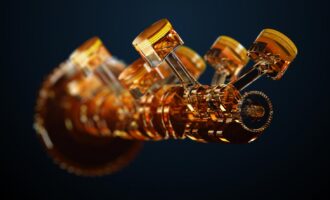The infinite possibilities of ionic liquids
By Cristine Villena Amurao
In the past decade, ionic liquids (ILs) or liquid salts have gained more attention as promising materials with a wide range of possible applications across many industries—ranging from pharmaceuticals, lubricants, bio-based/ renewable energy and advanced energy storage cells to the space industry.

“The power of ionic liquids in the infinite possible combinations you can create so that you will have the right functional groups to deliver the chemistry you want,” says Pranesh Aswath, professor and associate dean at the University of Texas at Arlington’s College of Engineering.
However, enthusiasm must be tempered with reality.
“Although some ILs are commercially available, they are still too expensive for high volume and low-price applications,” says David Dodds, president of Dodds and Associates based in Manlius, N.Y., U.S.A. Dodds has several decades of experience in organic chemistry and provides technical consulting and management to start-up pharma and biotech companies.
Aswath agrees. “In general, ILs are experimental at this point, and they are not being used in great quantities. There are still a lot of challenges that need to be worked out, such as compatibility challenges and solubility issues,” he says.
WHAT ARE IONIC LIQUIDS?
Put simply, ILs are salts that contain anions and cations. However, ILs have unique and interesting properties. They are salts in liquid state at room temperature with a melting point of less than 100 degrees centigrade and an iconicity of greater than 99%. Because they are relatively polar materials, they do not easily mix with solvents or non-polar products or molecules.
“Having low vapor pressure and low volatility gives ILs a big advantage over other materials,” says Aswath. “Another great advantage is its tuneability.”
To tune the chemistry of ILs means having the right functional groups for your purpose. The functional groups can be tuned so that the core structure has what you need, but the peripheral structures can be made hydrophilic or oleophilic. You have a choice as to what anion or cation to use at that specific site.
THE RACE TO REPLACE ZDDPS
Zinc dialkyl dithiophosphates or ZDDPs are the workhorse of the additive industry. “It is so inexpensive and playa dual role of anti-wear and antioxidant,” says Aswath. “In the U.S., the ZDDP market is roughly about USD 250 300 million, and the global market is probably three times that,” he says.
Aswath has been collaborating with several institutions in various countries developing proprietary ionic liquid chemistries. A U.S. patent application was recently published on the “synergistic mixtures of ionic liquids with other ionic liquids and/or with ashless thiophosphates for anti-wear and/or friction reduction applications,” which ultimately aims to replace ZDDP as a lubricant additive. Nicole Doerr, a principal scientist at AC2T, a laboratory in Wiener-Neusdtadt, Austria which supplies the ILs, is a co-inventor. More recently, Ali Erdemir, a distinguished fellow at Argonne National Laboratory in Lemont, Ill., U.S.A., joined the collaborative group working on finding the right combination of ILs to use for their research.
They have been working from the ground up on a superior anti-wear and friction reduction additive as an alternative to ZDDP, which can poison the catalytic converter. The proprietary compounds developed by Aswath and his collaborators are a mixture of at least one ionic liquid and at least one ashless antiwear compound. The ashless antiwear compound can be a second ionic liquid or an ashless thiophosphate compound. The mixture is diluted up to 25% by weight in base oil.
A group at Oak Ridge National Laboratory is conducting research on ILs as an anti-wear additive for next-generation, low viscosity, fuel-efficient engine lubricants. The group is led by Jun Qu, senior R&D staff scientist in the Materials Science and Technology Division at the laboratory in Oak Ridge, Tenn., U.S.A. Their approach differs from that of Aswath in that they are using existing, fully formulated oils combined with ILs to enhance their performance. They are developing oil-soluble ionic liquids as next-generation, ashless, anti-wear additives to allow the use of lower-viscosity engine oils.
Aswath acknowledges that while ILs won’t be a major additive in the near future, they could be in the long term.
Shell and Oak Ridge National Laboratory are also collaborating. The key to ILs’ success as a lubricant additive would depend on their ultimate price, which needs to be cost competitive. Aswath predicts that the use of ZDDP may only be decreased or eliminated due to concerns regarding emissions that arise from deposits on catalytic converters. “The regulation does not come from restricting the amount of ZDDP, but rather it comes from restricting emissions,” he said. The emissions are determined by how effective the catalytic converter is, and that is controlled by the amount of deposits on it.
“ZDDP is one of the primary culprits for forming deposits on catalytic converters, as the decomposition products of ZDDP form glassy deposits on catalytic converters and make them less effective. That has been the prime driver for reducing the amount of phosphorous in engine oils.”
Whoever wins the race or succeeds in getting a commercially viable product to market has one goal: Use ILs as oil additives because of their advantages over ZDDP, with their anti-wear properties, enhanced performance and friction reduction properties, plus their ability to act as corrosion inhibitors and/or detergents. This may be the most cost effective and cost-competitive use of ILs in the future, and it will be easier to penetrate the lubricants market as a drop-in product.
CURRENT INDUSTRIAL APPLICATIONS OF ILS
Although they may not be widely known or used, ILs exist in the market today. Eastman Chemical Co. was one of the first to commercialise ILs. It used phosphonium iodide ionic liquid as a solvent in the isomerisation of 3,4-epoxy but-1-ene to 2,5 dihydrofuran towards the production of tetrahydrofuran, which was then used as a chemical process solvent as well as an intermediate in the preparation of polymers. Eastman operated an IL plant producing 1,400 metric tonnes per year in Longview, Texas, U.S.A. from 1996 to 2004 when it was shut down due to declining demand in tetrahydrofuran.
Axens, an IFP Energies Nouvelles Group Company based in Paris, France, is an international provider of advanced technologies, catalysts and adsorbents. IFP was the first to operate an IL plant. Axens’ Dimersol™ process, which has been around since the 1970s, and Difasol™ process both use a nickel catalyst precursor using chloroaluminate ionic liquids as solvent. The Dimersol-X™ process changes olefins by dimerisation from butane to octane, which can be used later to create intermediates. The Dimersol-G™ process is used to dimerise light olefins like propene to make high-octane gasoline. There are about 35 plants worldwide producing 20,000 to 90,000 tonnes per year of dimer.
Difasol™ is similar to Dimersol™ and uses the same nickel catalyst precursor and chloroaluminate ionic liquids as solvent and can be retrofitted into existing Dimersol plants. A combined Dimersol-Difasol process or biphasic Difasol system seems to be better for several reasons: better use of the catalyst with reduced costs of both catalyst and catalyst disposal, better dimer selectivity, higher yield and smaller reactor size needed.

BASF also has worked on ILs at its headquarters in Ludwigshafen, Germany. About a decade ago, BASF introduced the Biphasic Acid Scavenging utilising Ionic Liquids (BASIL™) process at a technology transfer forum. BASIL has been commercially used, mainly in the pharmaceutical industry. BASF’s BASIL™ “smart” process technology uses ILs to scavenge acids that are by-products of organic processes such as esterification, thereby preventing decomposition of the primary reaction product or preventing unwanted side reactions. As the 1-alkyl imidazole reacts with the acid, an alkyl imidazolium salt is formed, which is an IL at the reaction temperature. The liquid alkyl imidazolium salt can then be easily removed by a liquid-liquid phase separation. In addition, economic reclamation of the 1-alkyl imidazole through deprotonation is possible.
BASIL™ is more than a technology for acid scavenging; 1-methylimidazole also acts as a catalyst and speeds up the reaction considerably. Consequently, it makes it possible to use a narrow, continuously operated jet reactor instead of a stirring vessel. The reactor is only thumb-sized but is able to produce hundreds of tonnes of product. Since 2002, the BASIL™ process has been used in the routine production of alkoxyphenylphosphines, handling ILs on a multi-tonne scale. Alkoxyphenylphosphines are important raw materials to produce BASF’s Irgacure® photoinitiators, which are used to cure coatings and printing inks by exposure to UV light.
BASF has other IL products, such as the BasionicsTM line, which are used e.g. as antistatic additives for a broad range of applications. They are also used as additives for coatings, adhesives, molding compounds and foams.
OTHER FUTURE INDUSTRIAL APPLICATIONS
In 1997, BP Chemicals described the oligomerisation of a mixture of alpha olefins (C6-C10) using acidic ILs to prepare synthetic lubricating oil base stocks with desirable lubricating properties such as a low pour point and a high viscosity index. In more recent years, Chevron has also researched the possibility of oligomerisation without an organic diluent and creating high viscosity polyalphaolefins. A look into the use of chloroaluminate ILs as liquid acid catalyst by BP researchers to produce ethylbenzene through the alkylation of benzene with benzene didn’t get beyond the laboratory because of cost issues.
A research group in China led by Xiaoqiang Fan and Liping Wang recently published its findings on ILs as possible high-performance space lubricating greases in the American Chemical Society Applied Materials & Interfaces Journal. The group believes that the highly conductive IL greases possess good thermal stability, good adaptive abilities to space environment, as well as excellent anti-wear and friction reduction similar to Aswath’s and Qu’s findings.
Future space travel and space tourism and the entry of private sector companies in the space industries might be a new application for ILs. Even with the recent setback due to the explosion of Virgin Galactic’s SpaceShipTwo Enterprise last October, the push for innovation and research in this field continues.
ILs also have been used to improve the transesterification reaction of triglycerides (vegetable oils) to produce biodiesel. Instead of using base catalysts (NaOH, NaMe or KOH) in the transesterification reaction of triglycerides with methanol, ILs such as Bronsted, Lewis and chloroaluminate acid ionic liquids can be used. They have been able to reuse/recycle the catalyst without loss of catalytic activity with good yield, but the processes still have significant limitations, such as long reaction times and destruction of catalyst when there is water in the reactant.
The use of ILs in biomass transformation, such as in processing lignocellulosic and cellulosic materials, has been investigated. However, the recovery and reuse of ILs after using them to dissolve biomass is difficult and expensive.
Lastly, advanced battery technologies are another potential application. Their use in lithium and lithium-ion cells, sodium and sodium-ion cells, magnesium batteries, metal-air batteries and dye-sensitized solar cells are all being studied. In addition, there are super capacitors, thermoelectrochemical cells and actuators that can benefit from the use of ILs.
The tuneability of ILs is the key to their versatility. This most interesting and promising property of ILs will keep them in a number of researchers’ arsenal as a potential answer to the industry’s needs, which might successfully connect academic research with industry—catapulting ILs to commercial reality.







